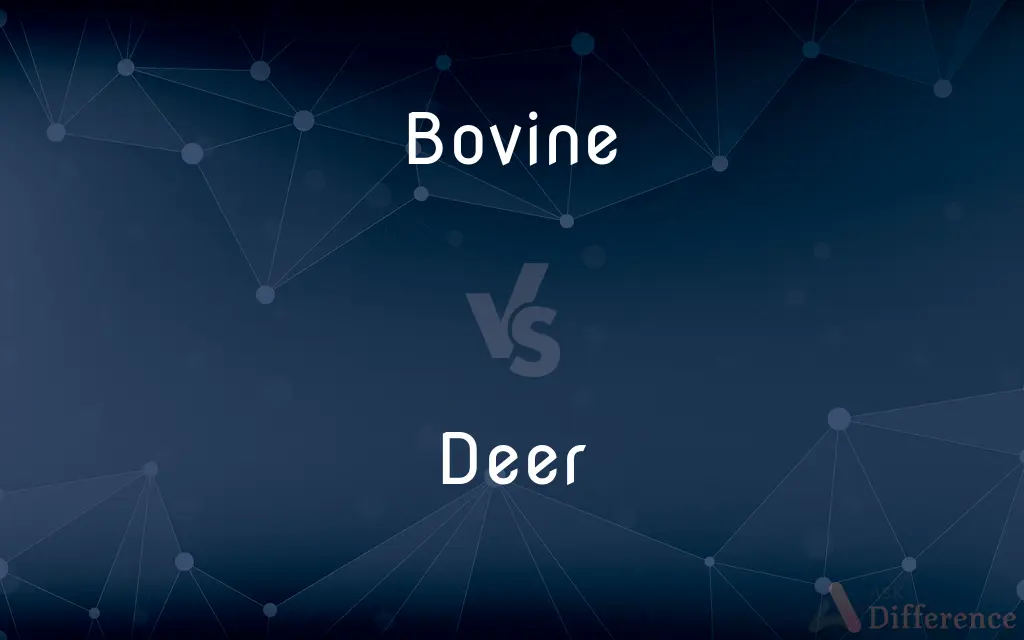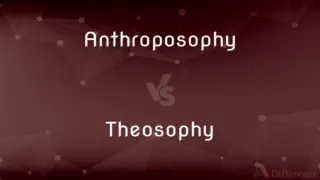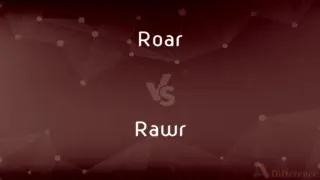Bovine vs. Deer — What's the Difference?
By Fiza Rafique & Urooj Arif — Updated on March 22, 2024
Bovines are domesticated or wild cattle, characterized by their size and utility, whereas deer are wild, nimble animals known for their antlers.

Difference Between Bovine and Deer
Table of Contents
ADVERTISEMENT
Key Differences
Bovines, part of the Bovidae family, encompass domestic cattle as well as wild species like bisons and buffaloes, known for their size, strength, and utility in agriculture and dairy production. These animals are often domesticated and play a significant role in human economies. Deer, belonging to the Cervidae family, are recognized for their graceful build and the presence of antlers in most male species. Unlike bovines, deer are primarily wild creatures, adapted to a variety of habitats and known for their agility and speed.
Bovines are typically larger and heavier than deer, with a more robust build suited for laborious tasks or meat and milk production. Their domestication has led to various breeds with specific characteristics tailored to human needs. Deer, in contrast, exhibit a leaner physique with long legs and are more adapted for swift movement in forested or rugged terrains. Their antlers, which can be shed and regrown annually, are a distinctive feature not found in bovines.
The social structure of bovines often involves herding, where groups live and move together, displaying complex social behaviors. This herding instinct is utilized in farming to manage and breed cattle effectively. Deer, while also social, tend to form smaller, more transient groups outside of mating seasons. Their social structures can vary widely among different species, from solitary to large herds depending on environmental conditions.
Comparison Chart
Family
Bovidae
Cervidae
Characteristics
Larger size, domesticated, utility in agriculture.
Antlers on males, agility, primarily wild.
ADVERTISEMENT
Habitat
Wide range, including farms and wild grasslands.
Forests, grasslands, and mountains.
Social Structure
Herding, with complex social behaviors.
Smaller groups or solitary, varying by species.
Usage
Meat, milk, labor (in some cultures), leather.
Game (hunting), antlers (decorative and medicinal).
Conservation
Many domesticated; some wild species are endangered.
Varied, with some species abundant and others at risk.
Compare with Definitions
Bovine
Large farm animals raised for meat, milk, and labor.
Bovines such as Holstein cows are predominant in dairy production.
Deer
Known for the antlers typically found on males.
Male deer, such as stags, grow and shed their antlers annually.
Bovine
Includes bisons and buffaloes, known for their size and strength.
The American bison, a wild bovine, roams the national parks.
Deer
Adapted to various habitats with swift and graceful movement.
Deer are often spotted darting through forests and meadows.
Bovine
Tend to live in groups, exhibiting complex social structures.
Bovines often form tight-knit herds for grazing and protection.
Deer
Includes numerous species like the white-tailed deer and elk.
The elk, a larger deer species, is admired for its impressive antlers.
Bovine
Integral to agriculture for their meat, milk, and hide.
Bovines are a key source of leather used in various industries.
Deer
Featured in various mythologies and revered for their beauty.
In many cultures, deer symbolize grace and gentleness.
Bovine
Characterized by their robust build and in some cases, horns.
Many bovine species possess horns used for defense and display.
Deer
Primarily herbivorous, with diets that include leaves and grass.
Deer are often observed foraging for food in the early morning.
Bovine
Of, relating to, or resembling a ruminant mammal of the bovid subfamily Bovinae, such as a cow, ox, or buffalo, especially one in the genus Bos.
Deer
Deer or true deer are hoofed ruminant mammals forming the family Cervidae. The two main groups of deer are the Cervinae, including the muntjac, the elk (wapiti), the red deer, the fallow deer, and the chital; and the Capreolinae, including the reindeer (caribou), the roe deer, the mule deer, and the moose.
Bovine
Sluggish, dull, and stolid.
Deer
Any of various hoofed ruminant mammals of the family Cervidae, characteristically having deciduous antlers borne chiefly by the males. The deer family includes the white-tailed deer, elk, moose, and caribou.
Bovine
An animal of the subfamily Bovinae, especially one of the genus Bos.
Deer
A ruminant mammal with antlers and hooves of the family Cervidae, or one of several similar animals from related families of the order Artiodactyla.
Bovine
(not comparable) Of or pertaining to cattle.
Deer
(in particular) One of the smaller animals of this family, distinguished from a moose or elk
I wrecked my car after a deer ran across the road.
Bovine
(not comparable) Belonging to the family, subfamily, tribe, or genera including cows, buffalo, and bison.
Deer
The meat of such an animal; venison.
Oh, I've never had deer before.
Bovine
Sluggish, dull, slow-witted.
Deer
Any animal, especially a quadrupedal mammal as opposed to a bird, fish, etc.
Bovine
An animal of the family, subfamily, tribe, or genera including cattle, buffaloes and bison.
Deer
Any animal; especially, a wild animal.
Mice and rats, and such small deer.
The camel, that great deer.
Bovine
Of or pertaining to the genus Bos; relating to, or resembling, the ox or cow; oxlike; as, the bovine genus; a bovine antelope.
Deer
A ruminant of the genus Cervus, of many species, and of related genera of the family Cervidæ. The males, and in some species the females, have solid antlers, often much branched, which are shed annually. Their flesh, for which they are hunted, is called venison.
Bovine
Having qualities characteristic of oxen or cows; sluggish and patient; dull; as, a bovine temperament.
The bovine gaze of gaping rustics.
Deer
Distinguished from Bovidae by the male's having solid deciduous antlers
Bovine
Any of various members of the genus Bos
Bovine
Of or relating to or belonging to the genus Bos (cattle)
Bovine
Dull and slow-moving and stolid; like an ox;
Showed a bovine apathy
Common Curiosities
How do bovines and deer adapt to their environments?
Bovines, especially domesticated ones, can adapt to a variety of environments including farms and pastures, whereas deer are adapted to wild habitats with their agility and foraging behavior.
Can deer be domesticated like bovines?
While deer can be kept in controlled environments, they are not domesticated in the same way bovines are, retaining much of their wild nature.
What sets bovines apart from deer in terms of physical build?
Bovines are generally larger and more robustly built than deer, which are leaner and more agile.
Do all deer species have antlers?
Most male deer species grow antlers, but the size and shape can vary greatly among species. Female deer generally do not grow antlers.
What is the significance of antlers for deer?
Antlers serve various purposes for deer, including defense against predators, competition among males during mating seasons, and as a display of physical fitness.
Are all bovines used for agricultural purposes?
While many bovines are used in agriculture for meat, milk, or labor, wild species like bisons and buffaloes are not typically used for these purposes.
How do the social structures of bovines and deer differ?
Bovines tend to form larger, more stable herds with complex social hierarchies, while deer may form smaller, less permanent groups, with social structures varying by species.
Are there conservation concerns for bovines and deer?
Some wild bovine species face conservation issues due to habitat loss and hunting, while certain deer species are also at risk, though others are abundant.
Is there any overlap in the habitats of bovines and deer?
While there can be overlap, especially with wild bovines and deer in natural habitats, domesticated bovines are more commonly found in agricultural settings.
What roles do bovines and deer play in human culture?
Bovines have been integral to agriculture and economy in many cultures, while deer are often revered in mythology and art for their beauty and grace.
Do bovines and deer have natural predators?
Yes, both can fall prey to large predators, but their defenses and social structures can offer protection.
Can the diet of bovines and deer overlap?
While both are primarily herbivorous, their diets can vary based on available vegetation, with bovines often grazing on grass and deer foraging for a variety of plants.
How do the reproductive strategies of bovines and deer differ?
Bovines have been selectively bred for agricultural purposes, affecting their reproduction, while deer follow natural breeding cycles often marked by seasonal changes.
Share Your Discovery

Previous Comparison
Anthroposophy vs. Theosophy
Next Comparison
Roar vs. RawrAuthor Spotlight
Written by
Fiza RafiqueFiza Rafique is a skilled content writer at AskDifference.com, where she meticulously refines and enhances written pieces. Drawing from her vast editorial expertise, Fiza ensures clarity, accuracy, and precision in every article. Passionate about language, she continually seeks to elevate the quality of content for readers worldwide.
Co-written by
Urooj ArifUrooj is a skilled content writer at Ask Difference, known for her exceptional ability to simplify complex topics into engaging and informative content. With a passion for research and a flair for clear, concise writing, she consistently delivers articles that resonate with our diverse audience.
















































